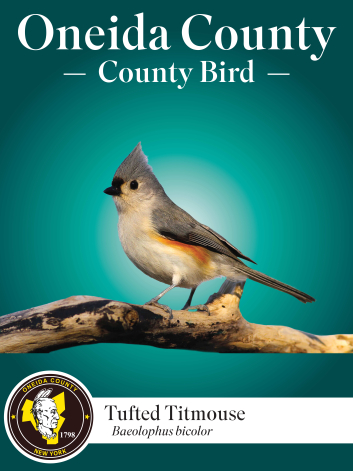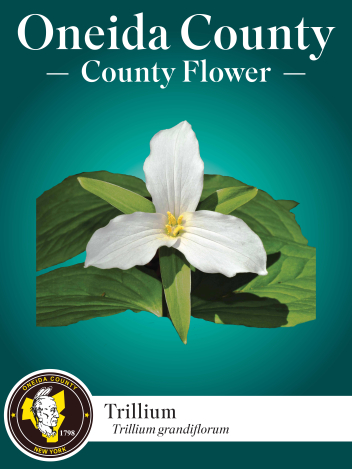November 3, 2023
Picente Unveils Oneida County Bird, Flower & Tree

County Executive Anthony J. Picente Jr. announced today that as part of Oneida County’s 225th anniversary, sixth graders across multiple districts have selected an official county bird, flower and tree.
The students chose the tufted titmouse as the county bird, trillium as the county flower and red maple as the county tree.
“Symbols play an important part in the identity of a community,” Picente said. “That’s why for our 225th anniversary, I wanted to give our residents a way to recognize the natural beauty of Oneida County and give them an even greater sense of pride in the place they call home. What better way to accomplish this than enlisting the young people who will carry on our traditions and lead this county into the future?”
Sixth graders from every school district in Oneida County were invited to vote on each county symbol, and over 1,100 participated through an online survey distributed and tallied by Cornell Cooperative Extension of Oneida County (CCE) in conjunction with the Oneida County Youth Bureau. The participating school districts were:
- Adirondack
- Camden
- Clinton
- Holland Patent
- New Hartford (Bradley, Hughes &, Myles Elementary Schools)
- New York Mills
- Remsen
- Rome (Bellamy, Denti, Gansevoort, John Joy & Ridge Mills Elementary Schools)
- Sauquoit
- Utica (Albany, Martin Luther King Jr., Jones & Kernan Elementary Schools)
- Vernon-Verona-Sherrill (McAllister Elementary School)
- Waterville
- Westmoreland
- Whitesboro (Parkway School)
The official Oneida County symbols were unveiled at Westmoreland Upper Elementary School.
“We appreciate the opportunity given to us by County Executive Picente to have our students engage in meaningful activities such as voting for issues that affect their community,” said Westmoreland Central School District Superintendent Rocco Migliori. “Being involved in this process teaches them that their voices matter and that they do have a say. This was a great experience for our students that also served as an authentic learning activity about climate, weather and nature, and why certain plants and trees thrive in particular areas.”
CCE presented sixth graders with three choices for each category based on birds, flowers and trees that are indigenous to and prevalent in Oneida County. Teachers of the participating classes also used the opportunity to incorporate the county symbols and civic engagement and pride into their lesson plans.
“Cornell Cooperative Extension of Oneida County was honored to work with the Oneida County Youth Bureau on County Executive Picente’s initiative to engage students in naming the official county bird, flower and tree,” said CCE Executive Director Mary Beth McEwen. “These symbols provide residents a physical, spiritual and cultural connection to our community. This was an exciting way to help celebrate the first 225 years of Oneida County, inspire pride among students and residents, and perhaps, even encourage future ornithologists, horticulturists and dendrologists.”
The final results of the voting were:
County Bird
- Tufted Titmouse 43%
- Blue Jay 38%
- Ruby Throated Hummingbird 19%
The Tufted Titmouse is common in eastern deciduous forests and a frequent visitor to bird feeders, where they prefer eating sunflower seeds. They are cavity nesting birds found year-round in Oneida County & across New York State. Since they cannot excavate their own nests, birdwatchers can attract them to their yards by putting up nest boxes.

County Flower
- Trillium 57%
- Milkweed 23%
- Bee Balm 20%
Trillium are white flowers that bloom in May and like areas of partial shade. This flower grows best in USDA Plant Hardiness Zones 4-8. They do not produce nectar, just pollen, and their seeds are spread by ants. They can be found across Oneida County in various natural settings, but are especially prevalent in the Rome Sand Plains area.

County Tree
- Red Maple 70%
- Hemlock 16%
- White Pine 14%
Red Maples thrive in sun to partial shade areas and are used commercially for both lumber and small-scale maple syrup production. The tree is best known for its brilliant yellow, orange and red foliage in autumn. Its ability to thrive in a large number of habitats is largely due to its ability to produce roots to suit its growing site from a young age. It grows in Hardiness Zones 3-9.

A red maple will be planted by the county at each participating school next year along with a commemorative plaque.
Video of today’s event: https://fb.watch/o4RPRTzPKY/.









